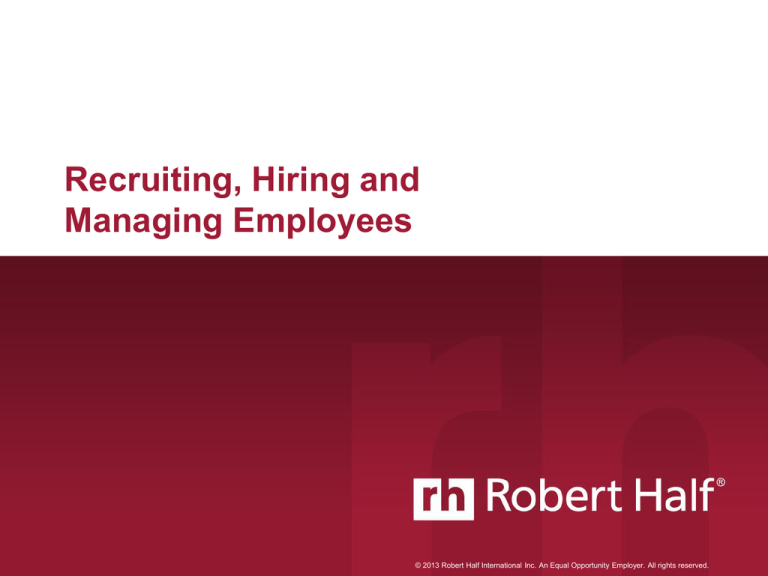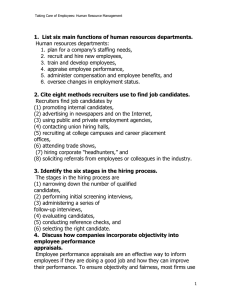
Recruiting, Hiring and
Managing Employees
© 2013 Robert Half International Inc. An Equal Opportunity Employer. All rights reserved.
Assessing Your Staffing Needs
Fill needs, not desks
Prepare a job description
–
–
–
–
–
Primary responsibilities
Secondary responsibilities
Experience required
Compensation
Preferred educational background
Researching the Market
Stay informed about local hiring trends
– Which firms are actively hiring staff?
– What’s the economic outlook for your region?
– Refer to the business section in your newspaper
– Review classifieds or online job postings
– Network with others in your field
– Actively participate in business organizations and
professional associations
– Ask peers about their recruiting experiences
Researching the Market
Salary trends
– Bureau of Labor Statistics (www.bls.gov)
– Industry publications
– Internet research
– Salary guides
Where to Find Candidates
Internal employees
– Have inside experience
• Know the firm’s “ins and outs”
• In tune with the office culture
Personal recommendations
– Evaluate using same criteria as other applicants
Where to Find Candidates
Staffing services
– Gain access to broad range of candidates
Networking
– Use all of your available resources
• Local trade organizations, business groups
• Job fairs, local colleges
• University alumni associations
Where to Find Candidates
Classified ads
– Popular option, but has drawbacks:
• Useless resumes
• Release of competitive information
– Give a snapshot of salary and benefits
– Answer two key questions:
• Why would someone want to work here?
• What separates this firm from others?
How to Review Resumes
Start with a system
– Be flexible
Review styles
– Chronological
– Functional
How to Review Resumes
Read between the lines
– Note typos and misspellings
– Read the resume from the bottom up
Follow up with phone calls
– Narrows the pool of applicants
– Saves time
Getting the Most Out of Interviews
Begin with easy openers
– Ask simple questions to put the candidate at ease
• “How did you hear about this job opening?”
Alternate types of questions
– Closed: “Did you enjoy your last job?”
– Open: “What did you enjoy most about your last job?”
Use hypothetical questions sparingly
Couch questions in behavioral context
Getting the Most Out of Interviews
Rephrase questions when needed
Listen
Take notes
End on a positive
The Evaluation Process
Assess candidates effectively
– Don’t fall victim to the “halo effect”
– Maintain perspective
– Limit input from others
Finalizing Your Decision
Check references
– Handle the process yourself
– Confirm reference’s ability to evaluate
candidate’s skills
– Verify candidate claims
– Don’t jump to conclusions
Finalizing Your Decision
Make the offer
– Don’t wait
Welcome new employees
– Provide an orientation
• Explain core values and expectations
• Clarify job responsibilities
• Give starting projects
• Assign a mentor
Managing Employees
Establishing open communication
Fostering teamwork
Creating a safe-to-risk environment
Empowering employees
Recognizing employee achievements
Conducting effective performance appraisals
Establishing Open Lines of
Communication
Talented people want ...
– To be heard
– To know what’s really going on inside
an organization
Schedule brainstorming sessions
Establishing Open Lines of
Communication
Listen
– Focus completely on the conversation
– Do not interrupt the speaker
– Build rapport
– Avoid prejudgment
Establishing Open
Lines of Communication
Be available
– Maintain an open-door policy
• Allot at least 20 percent of your day to unscheduled
interactions with staff
• Make sure employees have no trouble
reaching you
• Take an honest look at your schedule
and behavior
Fostering Teamwork
Establish a common goal
– Why does the team exist?
Set up processes
– Making decisions
– Sharing information
– Resolving conflicts
Fostering Teamwork
Encourage idea-sharing
– Make sure everyone participates
Get involved
– Work alongside your team
Creating a
Safe-to-Risk Environment
Encourage reasonable risk
– Ask for your employees’ input
– Respect candor
– Reward risk-taking, no matter how it turns out
Empowering Employees
Offer autonomy
– Make recommendations instead of giving commands
– Give decision-making power
Ask employees to devise solutions
– Don’t provide all the answers
Recognizing Achievements
Give day-to-day praise and recognition
– Say “good morning” and “thank you”
– Show you value their contributions
• Initiate social activities for staff
• Send birthday cards
• Provide personal or public recognition
• Give small gifts for special occasions
• Offer tickets to sporting events and shows
• Provide free coffee and snacks
Conducting Effective
Performance Appraisals
Make them a year-round process,
not a one-time event
Engage in a two-way dialogue
Deliver negative feedback with care
Establish goals
Recruiting, Hiring and
Managing Employees
roberthalf.com
© 2013 Robert Half International Inc. An Equal Opportunity Employer. All rights reserved.








